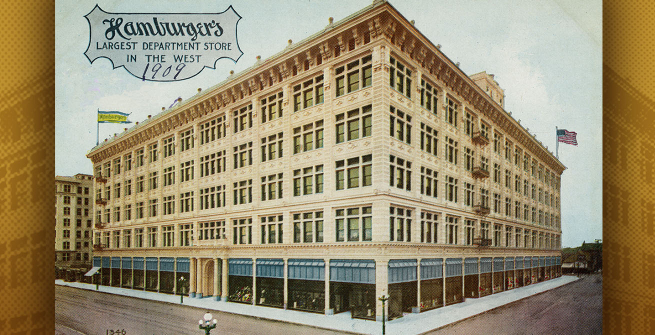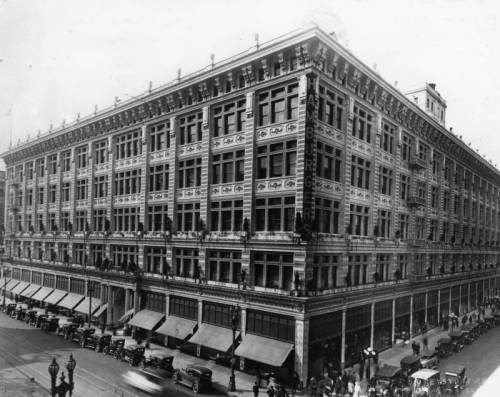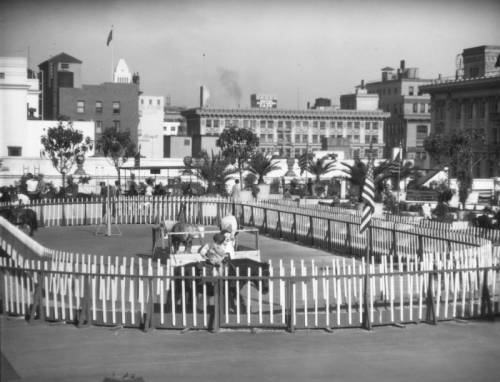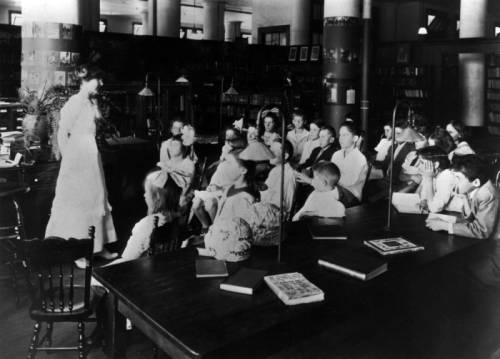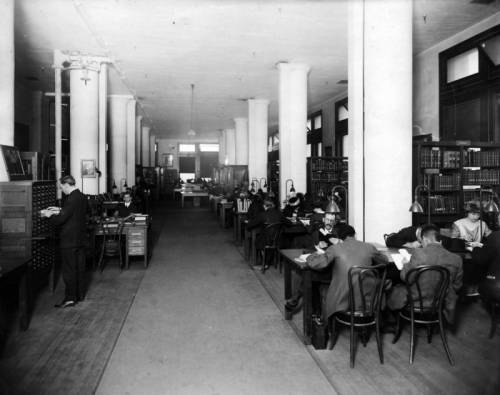Have you ever visited a library in the middle of a department store? If you lived in Los Angeles in the early twentieth century, you could have done just that. The Hamburger Building, designed by architect Alfred F. Rosenheim, opened at 8th Street and Broadway in August 1908. Most of the building was taken up by the Hamburger's Department Store (which started as A. Hamburger & Sons on Main Street in 1881), and additional space was rented out. A portion of the third floor of the Hamburger Building was the home of the Los Angeles Public Library from 1908 until 1914. This was the library's fourth location [following the Downey Block (1872-1889), City Hall (1889-1906), and the Homer Laughlin Annex (1906-1908)], and the growth of the library necessitated each move. During the tenure of City Librarian Charles Fletcher Lummis, the library moved into the Homer Laughlin Annex (a space that was outgrown relatively quickly) and the Hamburger Building, where a five-year lease was signed. According to a Los Angeles Herald article, the Library Board picked their location for the library within the building, choosing frontage along 8th Street because the northern light was "considered the most desirable for library purposes." The board also insisted that the library have a separate entrance from the department store.

The Hamburger Department Store was huge! The Los Angeles Times reported that a crowd of 75,000 people descended upon the store on opening day. Spanning 8th Street between Broadway and Hill, with six floors and a basement, there was much to see. Across 15 acres of department store space, in addition to your standard departments (e.g., clothing, shoes), there was an emergency hospital, along with dentist and podiatrist offices; a post office; telegraph office; information bureau and ticket office for railway lines and steamships; a grocery store; bakery; butcher and more. The store also boasted the first moving stairway (aka escalator) west of the Mississippi River, which supposedly had a constant line to ride on opening day. The Main Library (it would not be known as the Central Library until the current location opened in 1926) moved into a portion of the third floor just a month after the department store opened.
Beginning September 7, 1908, books and fixtures were shuffled out of the Homer Laughlin Annex and into the Hamburger Building. City Librarian Charles Fletcher Lummis praised his organization skills in newspapers and in the library's annual report, where he noted that only the department being moved was shut to the public. Patrons had access to both locations until the library opened at 9 a.m. on September 10, 1908, in its new location. Interestingly, the Woodbury Business College (now known as Woodbury University) opened on the same day on the fifth floor of the Hamburger Building. Newspapers reported that Mr. Lummis was a guest speaker at Woodbury's opening reception.
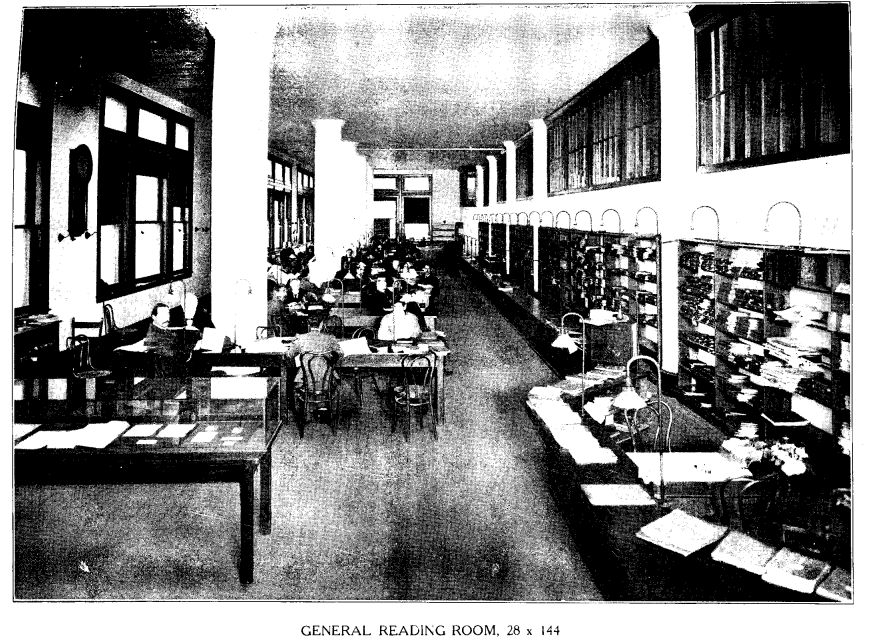

Woodbury Business College and the Los Angeles Public Library shared an entrance at 320 W. 8th Street. Five elevator cars and stairs took patrons up to the library. While the library had a large portion (32,000 sq ft) of the third floor, the rest of the floor was given over to the department store, including the furniture department, the piano department (newspapers boasted there were some "400 pianos of every kind, size, description, and variety"), garden tools, hand tools, and housewares (including dinnerware, hotel ware, kitchen gadgets, lamps, and cut glass).


Looking at the floor plan of the library space, it's evident that the design made life difficult for patrons and library workers alike. The largest public spaces of the library, the General Reading Room and the Reference Room, ran the length of 8th Street between Broadway and Hill and were separated by the elevator bank and the lobby. Patrons had to walk several hundred feet from the General Reading Room to the Reference Room. Lummis was a fan of closed stacks, which were inaccessible to the public. Patrons had to request each item they wanted at the General Delivery Desk, and a library attendant would retrieve it. To make matters more difficult, the card catalog was initially in the lobby near the General Delivery Desk. The librarian would have to leave the Reference or Reading Room to consult the card catalog. Older newspapers were stored in the Hamburger Building's attic, where the library had 10,000 sq ft of storage space. Meanwhile, the library's newspaper reading room took up 3,000 sq ft in the basement. The distance between this newspaper reading room and the storage area meant a longer wait for older newspaper requests while an attendant ascended the stairs or crowded elevators to retrieve the requested newspaper.
The roof garden, according to Lummis in the 1908-09 annual report, was among the Hamburger Building’s finest selling points. Lummis gushed about this roof garden's superiority over the old roof garden at the Homer Laughlin Annex. The Hamburger Building's roof was four times the size, it was covered with felt, and the view offered an "unbroken horizon of mountains, city, and sea." Lummis sold the plants that had been part of the roof garden at the Homer Laughlin Annex, and purchased new plants and planters (redwood plant boxes and fifty ten-hoop barrels) for the Hamburger roof garden. While a portion of this roof garden was set aside for library visitors, the majority of the roof was for all who visited the Hamburger Building. Over the years, the roof garden was the site of musical recitals, baby contests, tennis matches, car shows, alongside reading in the sunshine. [Roof gardens were popular in early twentieth-century Los Angeles. The nearby Bullock's department store at Broadway and Seventh even had a storyteller who entertained children on Saturday afternoons on their roof garden.]

The move to the Hamburger Building certainly had its detractors. Not long after the library's opening, Pacific Outlook published a scathing article about the library's placement in the middle of a department store and the loss of a tranquil space for reading and research. Now, that author lamented, the library's name was part of the "artful tooting" of the elevator boy as he called out the departments available on each floor. There were problems with the building itself and its location. For one thing, the lighting in the library was inadequate. There was one ceiling lamp per 40 square feet, necessitating using table lamps throughout the library. The 1907-08 annual reports mentioned a fear that the new building might be too far from the "business center" of Los Angeles. Lummis noted that before leasing the space, a survey was done to measure passenger traffic on the streets and building activity in the surrounding area, and the results were favorable.
There were some positive aspects to the move into the Hamburger Building. The library's location probably meant people who had never visited the library could wander in to check it out. More people signed up for library cards. According to the annual report, October 1908 showed the highest number of new library cardholders in the library's history. [To get a library card, a person had to have their name in the city directory (similar to the phone book) or have someone in the city directory co-sign for them.] The additional space available at the new location also meant there was room to purchase new books. Fortunately, Lummis' knowledge and reputation on matters of Southwest history benefited the library as he built up what he called the Department of Western History Material.

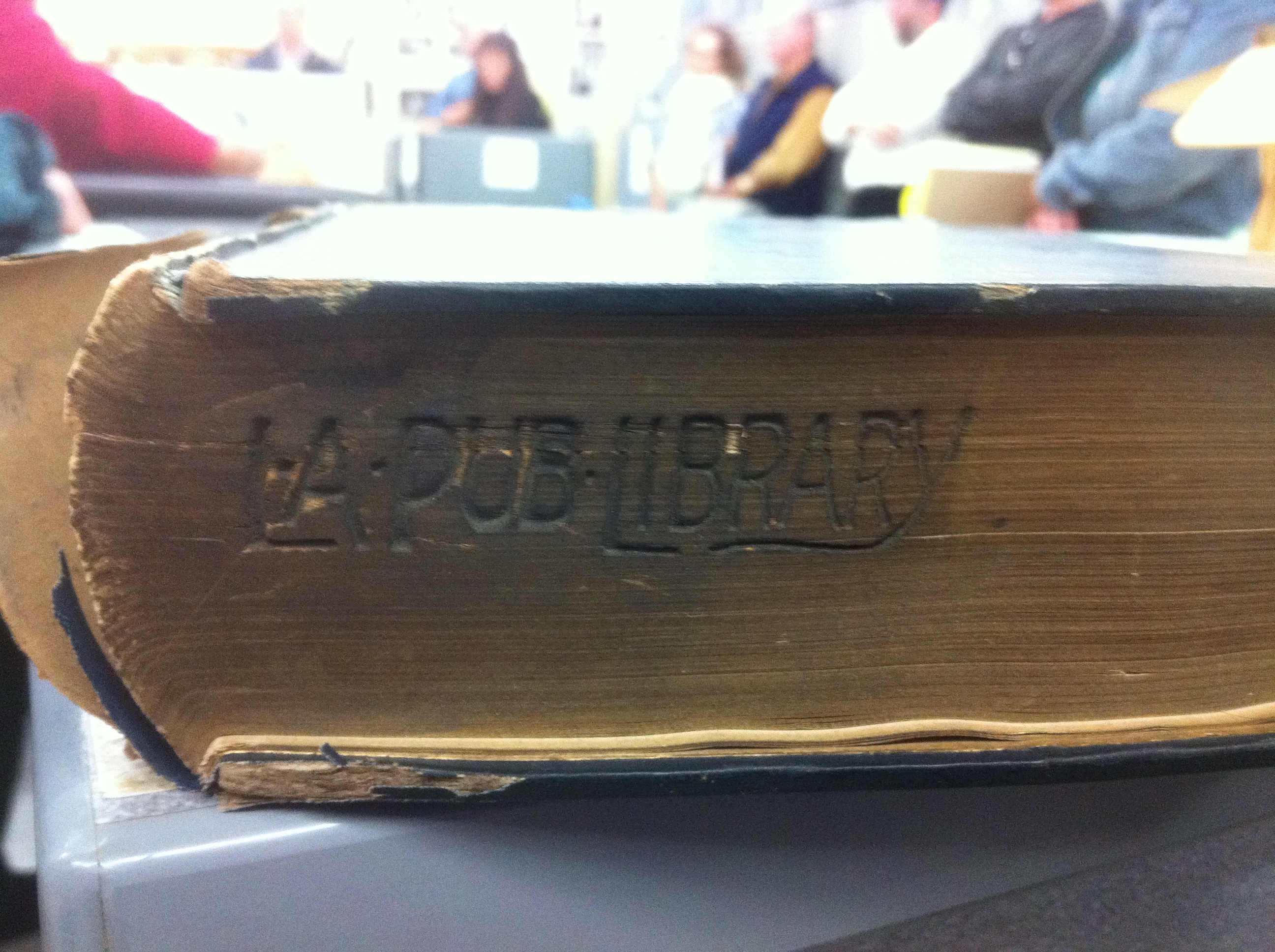
The story of Lummis' rocky path to City Librarian has been well-documented. His time in the position and 1910 resignation were problematic as well. In American Character, biographer Mark Thompson noted that Lummis' diary frequently indicated his library work took 12-16 hours a day, often seven days a week. Unfortunately, for the library's sake, the work was mostly done from El Alisal, Lummis' Arroyo Seco home. Per Thompson, citing an unnamed person on the Library Board, Lummis was completely absent from the library for 75 days in 1908. When he resigned in March 1910, Lummis returned to his writing and devoted time to his passions, including preserving the California missions and building the Southwest Museum. [Fun fact: the Southwest Museum was also a tenant of the Hamburger Building, located there (rent-free) from 1908-1914.] Distressing innovations during Lummis' years as City Librarian included branding books to discourage theft. Another, that Lummis jokingly called the 'Poison Label' or the 'Literary Pure Food Act,' involved a label that was placed into books he considered of questionable literary merit. As he put it in the 1908-09 annual report, the labels were there "to safeguard amusement-readers from the degenerate in fiction and [the library's] students from ptomaine history."
[The library's] experience since being in the present quarters has convinced the Board that this location is undesirable and that as long as the library continues to remain therein, it will not accomplish all of the good it should. Situated on the third floor of a large department store building, it appears to the ordinary passerby, because of its unavoidable setting, it is part of the department store itself.
-Twenty-second Annual Report of the Board of Directors of the Los Angeles Public Library, [1909-10]
Following Lummis' resignation, Assistant Librarian Celia Gleason acted as interim director while the Library Board searched for a new City Librarian. According to the 1909-1910 annual report, the Library Board was considering, "What are the essential requirements of the librarianship? And who is, among those available, best able to fill them?" The board also knew that a move was on the horizon because the library had outgrown the department store in more ways than one. According to the Los Angeles Evening Express, the Library Board contacted libraries and librarians around the United States, asking for recommendations for a City Librarian replacement. St. Joseph (Missouri) Public Library director Purd B. Wright's name was given by more than one respondent. The board approached Mr. Wright to see if he would allow himself to be considered to lead the Los Angeles Public Library. Luckily he said yes, and arrived in Los Angeles to begin work in August 1910. [The first Carnegie-funded library in Missouri was St. Joseph's main library which Wright negotiated. The board no doubt hoped he would help Los Angeles build its own Central Library.]

The new City Librarian, Purd B. Wright, hit the ground running. He attended the American Library Association (ALA) convention in Michigan on his way to Los Angeles. He convinced ALA to hold their next convention in Southern California for the first time. In his first months on the job, he addressed various organizations about the importance of the library and proved himself worthy of the job. The Los Angeles Times literary critic Willard Huntington Wright (aka the pseudonymous S.S. Van Dine, creator of 'Philo Vance') wrote of the skills required to be City Librarian and laid out why he thought Purd Wright would be a great fit for Los Angeles. Namely, Mr. Wright had a track record of getting libraries built while in St. Joseph, and he was a proponent of open stacks, which allowed readers to choose for themselves what to read.
Purd Wright had a reputation as a progressive librarian who could get things done, so it's no surprise that other library systems sought him out. The Kansas City (Missouri) Public Library offered him their top position early in January 1911. Meanwhile, Wright championed Los Angeles as a location for Carnegie-funded libraries, and in late January 1911, the Library Board received word. Andrew Carnegie would give Los Angeles $210,000 for six library branch buildings as long as the city would furnish and maintain the branches (an expense of $21,000). Wright also pushed to get funds for a Central Library building, but Carnegie held fast that the branches would give greater access to people in the growing metropolis.
By the time Purd Wright resigned in March 1911 to accept the library director job in Kansas City, he'd done quite a lot for Los Angeles and the library. In addition to negotiating with Carnegie, he removed wooden partitions in the book stack area, which allowed patrons to browse the shelves and choose their books. He also implemented the policy of issuing library cards to any child who could write their name. Another popular and time-saving feature was the move of the newspapers into the Main Reading Room, which saved the library the $600 rental fee for the basement newspaper reading room. It increased the hours the newspapers were available to patrons. Plus, patrons could finally sign up for a library card at their local deposit branch instead of traveling to the Main Library for a card.
Once again, Assistant Librarian Celia Gleason was put in charge while the Library Board searched for a new City Librarian. The Library Board "surveyed the field" and chose Everett Robbins Perry, a Harvard graduate who attended New York State Library School at Albany and held various positions within the New York Public Library. [The New York Public Library's Main Library was opened while Perry worked there, so he was aware of the difficulties of moving a library. Undoubtedly an asset in the Library Board's eyes.] He resigned as head of the NYPL Information Department, where he oversaw their vast reference collection, to accept the top job at the Los Angeles Public Library.

Just like Wright, Everett R. Perry quickly got to work. According to newspaper reports on Mr. Perry, five of the six Carnegie-funded branch library sites had been chosen within two weeks of starting as City Librarian (Highland Park/Arroyo Seco, Vermont Square, Boyle Heights, East Los Angeles/Lincoln Heights, and Vernon), and there were already discussions with civic organizations and community members about where to locate a Central Library. In the 1911-12 annual report, Perry reiterated the difficulties of working in the Hamburger Building. For example, the library could only be reached by elevator, and the layout of the library was inconvenient to both patrons and staff. The combined circulation at the branches surpassed the circulation at the Main Library for the first time in the library's history. This was likely a result of the difficulties accessing the Main Library and the expansion of branch service. In 1912, Celia Gleason resigned as Assistant Librarian to become County Librarian for the newly formed Los Angeles County Public Library. In October 1912, Joseph L. Wheeler, formerly of the Jacksonville (FL) Public Library, became the new Assistant Librarian. Newspaper accounts emphasized his role in popularizing and publicizing the library.
Everett Robbins Perry was full of innovations. He created an Information Desk at the Main Library, where an attendant would help readers use the card catalog, find the book they were looking for, or answer reference questions. Perry immediately reorganized departments, which boosted the overall efficiency of the library (e.g., the Catalogue, Classifying, and Accession departments merged to handle the processing of books; the Fiction and General Literature departments merged to form the Circulation Department). He implemented a delivery system whereby patrons at branch libraries could request books from the Main Library, which were then delivered to the branches every other day. Tlibrary'sy's bindery moved into the attic of the Hamburger Building, which eliminated the need to send out books for repair or permanently bind magazines and newspapers, and got the materials back on the shelf faster. Additionally, Perry undertook a full inventory of tlibrary'sy's collection, which had not been done in years (previous inventories were done piecemeal by Dewey Decimal class/classification, e.g., Fiction or the 700s). One newspaper article initially noted that approximately 20 percent of the book collection had gone missing (either by theft or overdue/unreturned items), but tlibrary'sy's annual report that followed the full inventory listed approximately a 4% loss. Either way, the method of sending overdue notices was revamped to curb book loss. A machine embossed "Los Angeles Public Library" on the books also helped discourage theft.
It was time to find another location for the library. With the library's lease due to expire on July 1, 1913, the members of the Library Board agreed that signing another five-year lease at the Hamburger Building would not be beneficial. Their main concern, according to the 1912-13 annual report, "was "principally for the reason that library's] location associates it too closely with a commercial institution." Instead, they signed a one-year lease at the Hamburger Building and began looking for a new home while wishing for a permanent library building. After searching various options, the Library Board signed a lease for the seventh, eighth, and ninth floors of the Metropolitan Building, which was under construction on the northwest corner of 5th and Broadway. During the last week of May 1914, the library packed up and moved out of the department store. The new location in the Metropolitan Building provided a more accessible and efficient location for library patrons. It provided increased space, better lighting and ventilation, and elevators that deposited visitors at the library's doors in the heart of the business and shopping district. The library stayed in the Metropolitan Building until the move into its current location. The Central Library at Fifth and Flower has remained the library's home since July 1926.
